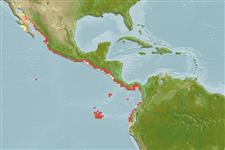Common names from other countries
Environment: milieu / climate zone / depth range / distribution range
Ecologia
marinhas; estuarina; intervalo de profundidade 0 - 50 m (Ref. 189). Tropical; 30°N - 5°S, 115°W - 76°W (Ref. 189)
Eastern Pacific: Magdalena Bay, Baja California on the Pacific coast and from San Felipe Bay, Gulf of California south to Gulf of Guayaquil, northern Peru.
Comprimento de primeira maturação / Tamanho / Peso / Idade
Maturity: Lm 10.8, range 11 - 11 cm
Max length : 25.0 cm TL macho/indeterminado; (Ref. 96339); common length : 12.5 cm SL macho/indeterminado; (Ref. 9298); peso máx. publicado: 57.40 g (Ref. 91172)
Descrição suscinta
Chaves de identificação | Morfologia | Morfometria
Espinhos dorsais (total) : 0; Espinhos anais: 0; Raios anais : 26 - 29. Snout moderate, pointed, tip at or just above eye center; maxilla moderate, tip pointed and reaching onto pre-operculum (but not beyond), extending beyond second supra-maxilla; sub-operculum with a distinct triangular projection on hind margin; lower gill rakers fine and slender, increasing in larger fishes. Silver stripe along flank ,probably disappearing in larger fishes.
Occurs inshore along sandy beaches and in tide streams, forming large schools. Juveniles to about 7 cm occur on beaches and in bays, thereafter moving further from the shore. Feeds by filtering phytoplankton and zooplankton.
Ciclo de vida ou comportamento de acasalamento
Maturities | Reprodução | Spawnings | Egg(s) | Fecundities | Larvas
Spawn in school (Ref. 205).
Whitehead, P.J.P., G.J. Nelson and T. Wongratana, 1988. FAO Species Catalogue. Vol. 7. Clupeoid fishes of the world (Suborder Clupeoidei). An annotated and illustrated catalogue of the herrings, sardines, pilchards, sprats, shads, anchovies and wolf-herrings. FAO Fish. Synop. 125(7/2):305-579. Rome: FAO. (Ref. 189)
Status na Lista Vermelha da UICN (Ref. 130435)
CITES (Ref. 128078)
Not Evaluated
Ameaça para os humanos
Harmless
Uso pelos humanos
Pescarias: pouco comercial; isca: usually
Ferramentas
Relatórios especiais
Baixar XML
Fontes da internet
Estimates based on models
Preferred temperature (Ref.
115969): 22.3 - 28.5, mean 26.3 (based on 48 cells).
Índice de diversidade filogenética (Ref.
82804): PD
50 = 0.6250 [Uniqueness, from 0.5 = low to 2.0 = high].
Bayesian length-weight: a=0.00617 (0.00407 - 0.00934), b=3.23 (3.11 - 3.35), in cm Total Length, based on LWR estimates for this species & (Sub)family-body (Ref.
93245).
Nível Trófico (Ref.
69278): 2.7 ±0.30 se; based on food items.
Resiliência (Ref.
120179): Elevada, tempo mínimo de duplicação da população menor que 15 meses (Preliminary K or Fecundity.).
Fishing Vulnerability (Ref.
59153): Low vulnerability (15 of 100).
